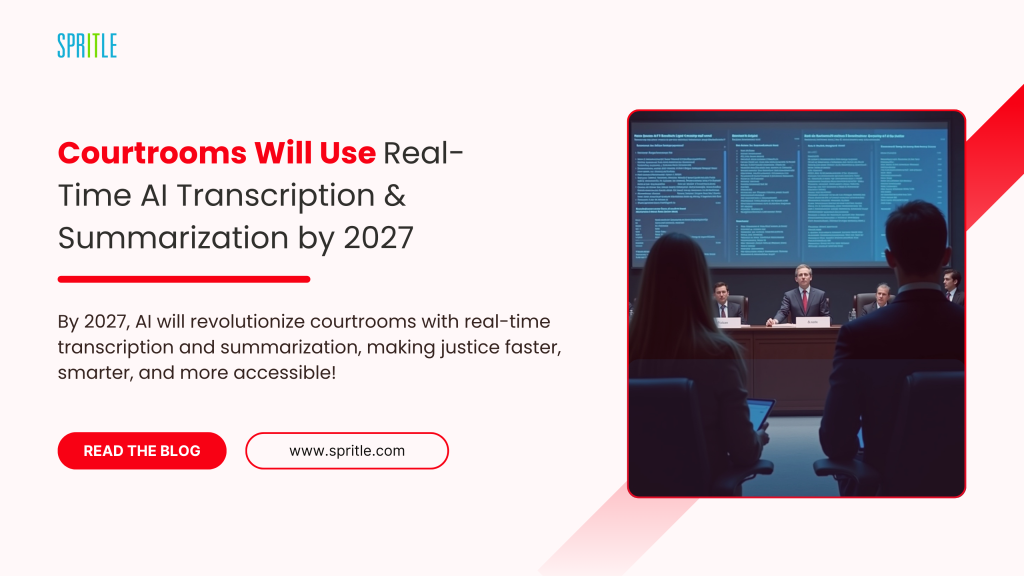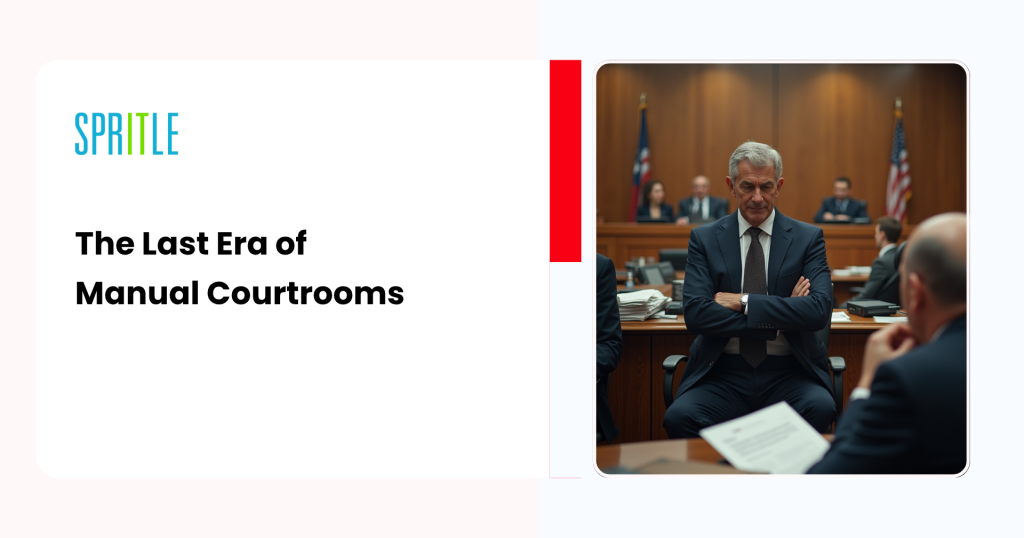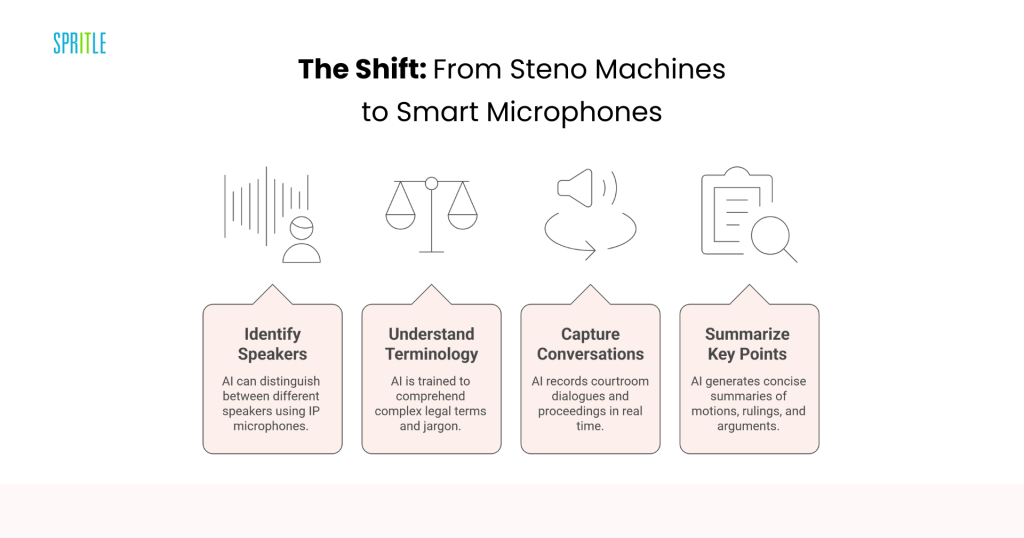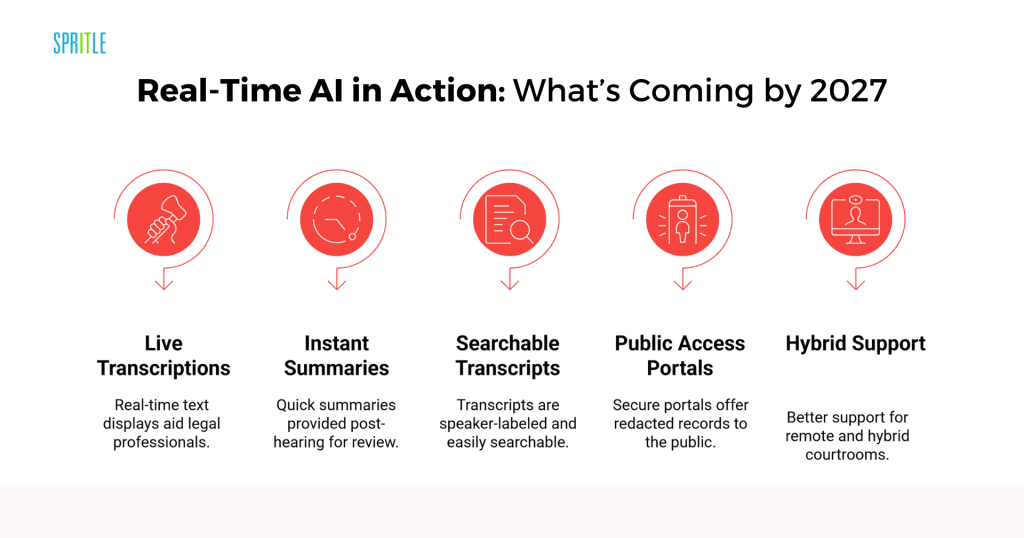
A smarter, faster future for justice is already taking shape
“Let’s reschedule the hearing.”
The courtroom sighs. The stenographer called in sick, and there’s no backup. It’s the third delay this month. Witnesses are asked to return later. Lawyers juggle calendars. The judge apologizes. Time — and money — is lost.
This scene, while common, is no longer necessary. In a world where meetings are transcribed instantly and voice assistants answer complex questions, why is the legal system still stuck in manual transcription mode?
The truth is: it’s not for long.
By 2027, most courtrooms will use real-time, AI-powered transcription and summarization tools to capture and manage legal proceedings — accurately, securely, and far more efficiently.

The Shift: From Steno Machines to Smart Microphones
Court proceedings require every spoken word to be recorded and archived — a critical part of legal transparency and due process. Current technology, however, is catching up.
AI-powered summarization, Natural Language Processing (NLP), and Automatic Speech Recognition (ASR) are revolutionizing the way courts record events that take place in the courtroom.
Simple voice-to-text technologies are not what they are.
Today’s AI can:
- Identify multiple speakers (IP mikes)
- Understand legal terminology
- Capture conversations in real time
- Summarize key motions, rulings, and arguments
The result? Transcripts that are more accessible, searchable, and reliable — produced in seconds, not days.

Why This Matters for the Legal System
🕒 Faster Case Resolution
AI delivers transcripts as the hearing unfolds. No delays, no backlogs. Judges can refer to live notes, and attorneys can access key quotes instantly.
💸 Cost Efficiency
Hiring and training human court reporters is costly — and shortages are increasing. AI helps courts operate more efficiently, especially in underserved regions.
🔍 Searchable Proceedings
Imagine typing “Motion to Dismiss – Smith Case” and instantly seeing the moment it happened. Transcripts are transformed by AI into searchable information bases for the general public, clerks, and lawyers.
♿ Better Access to Justice
But AI for Courts Isn’t “Plug-and-Play”
Even while the advantages are obvious, it’s crucial to realize that courtroom AI isn’t a novel approach. Careful preparation and personalization are necessary for true implementation. This is the reason:
🎓 Legal-Specific Language
Courtrooms don’t speak like boardrooms. Legal expressions like “objection overruled,” “in chambers,” and “pro se” call for more than simply word identification; they also demand contextual knowledge.
👥Multiple-Speaker Settings
Clerks, witnesses, attorneys, and judges frequently interrupt each other. AI must accurately attribute remarks, handle overlapping discourse, and identify speakers.
🧠 Summarization ≠ Transcription
AI summarization is about distilling key events — like motions, objections, or rulings — into clear takeaways. It’s a higher-level function that requires context-aware intelligence.
🔐 Security and Admissibility
Legal records must comply with strict data protection laws and may become evidence in future proceedings. AI must ensure secure storage, audit trails, and integration with case management systems.
Where Spritle Software Fits In: Making the Future Practical
At Spritle, we don’t build the core AI models — but we do make them work where it matters most.
We act as a strategic integration partner for governments, legal tech providers, and digital transformation teams, helping them:
- Select the right AI engines for transcription and summarization
- Teach AI to recognize speakers and use legal terminology.
- Make sure deployments are safe and compliant.
- Integrate AI into current judicial procedures and systems in a seamless manner.
We don’t push a product. We enable the system that makes it all possible.
What’s the Difference Between Transcription and Summarization?
This is important to understand:
- Transcription is like a script. It writes every word, speaker by speaker.
- Summarization is more like a report. It tells you what happened, what was decided, and why it matters.
The best AI tools can do both — giving judges, lawyers, and clerks a clear picture of what happened in the courtroom, without wading through pages of raw text.
From ESPN Replays to Courtroom Records
Let’s put it in perspective.
Think of courtroom AI like an ESPN replay center for justice. Every word, every ruling, every exchange — recorded, searchable, and reviewable with precision.
Or imagine AI-generated transcripts acting like a Google search for legal hearings. You don’t just scroll through pages of text — you find exactly what you need, when you need it.
This isn’t wishful thinking. It’s already happening in pilot programs and legal tech startups. By 2027, it will be mainstream.
Real-Time AI in Action: What’s Coming by 2027
In the near future, here’s what courtrooms can expect:
✅ Live transcription displays for judges and attorneys
✅ Instant summaries delivered after each hearing
✅ Speaker-labeled, searchable transcripts integrated with case files
✅ Public access portals with secure, redacted records
✅ Improved support for hybrid or remote court settings
Above all, AI will enable courtroom employees to concentrate on high-value work rather than tedious note-taking, not replace them.

Last Thought: Get Building Right Away Rather Than Waiting for the Wave
The justice system can’t afford to lag behind.
Delays hurt real people. Backlogs cost taxpayers. Inaccurate records can compromise fairness. But with the right AI tools and smart implementation, courts can become faster, fairer, and more accessible than ever.
At Spritle Software, we’re already helping organizations bridge the gap — not by promising magic, but by making the future functional.
2027 is closer than you think. And the transformation of legal documentation is already underway.
